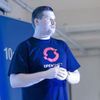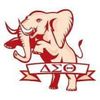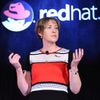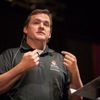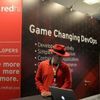Schedule
Tuesday, 2nd May
Ansible BoF![]()
![]()
Greg DeKoenigsberg (Director, Ansible Community Red Hat), Robyn Bergeron (Ansible Community Architect Red Hat)
45 minutes session
- Greg DeKoenigsberg (Director, Ansible Community Red Hat), Robyn Bergeron (Ansible Community Architect Red Hat)
- 45 minutes session
Room 155
Tuesday, 2nd May, 10:15 - 11:00
- Birds of a feather
On the path to persistent memory![]()
Linda Knippers (Distinguished Technologist Hewlett Packard Enterprise)
45 minutes session
- Linda Knippers (Distinguished Technologist Hewlett Packard Enterprise)
- 45 minutes session
Room 158
Tuesday, 2nd May, 10:15 - 11:00
- Birds of a feather
Technological pivot points lightning talks![]()
![]()
![]()
Tom Corcoran (Specialist Solution Architect Red Hat), Tom Coughlan (Sr. Sw. Eng. Mgr. Red Hat), Steven Carter (Chief Cloud Architect Red Hat)
45 minutes session
- Tom Corcoran (Specialist Solution Architect Red Hat), Tom Coughlan (Sr. Sw. Eng. Mgr. Red Hat), Steven Carter (Chief Cloud Architect Red Hat)
- 45 minutes session
Room 101
Tuesday, 2nd May, 10:15 - 11:00
- Lightning talk
Unleash innovation with Red Hat cloud management and modern app development![]()
![]()
Mauricio Leal (LATAM Developer Experience Expert Red Hat), Vagner Farias (Cloud and Virtualization SME Red Hat)
45 minutes session
- Mauricio Leal (LATAM Developer Experience Expert Red Hat), Vagner Farias (Cloud and Virtualization SME Red Hat)
- 45 minutes session
Room 157C
Tuesday, 2nd May, 10:15 - 11:00
- Breakout session
Red Hat JBoss BPM Suite Primer: Capabilities, Vision and Roadmap![]()


Prakash Aradhya ( Red Hat), Ryuji Kurokawa (COO iSmart Technologies Corporation), Tetsuya Kimura (CEO iSmart Technologies Corporation)
45 minutes session
![]()
![]()
- Prakash Aradhya ( Red Hat), Ryuji Kurokawa (COO iSmart Technologies Corporation), Tetsuya Kimura (CEO iSmart Technologies Corporation)
- 45 minutes session
Room 153C
Tuesday, 2nd May, 10:15 - 11:00
- Breakout session
From legacy to microservices: Lessons learned on the road to success by Miles & More![]()
![]()
Matthias Krohnen (Manager IT, Lead Innovation Lab Miles & More GmbH), Torben Jaeger (Middleware Specialist Solution Architect Red Hat)
45 minutes session
- Matthias Krohnen (Manager IT, Lead Innovation Lab Miles & More GmbH), Torben Jaeger (Middleware Specialist Solution Architect Red Hat)
- 45 minutes session
Room 153B
Tuesday, 2nd May, 10:15 - 11:00
- Breakout session
OpenShift for operators![]()
Erik Jacobs (Principal Product Marketing Manager Red Hat)
2 hour session
- Erik Jacobs (Principal Product Marketing Manager Red Hat)
- 2 hour session
Room 251
Tuesday, 2nd May, 10:15 - 12:15
- Instructor-led lab
Hands on with Red Hat Satellite 6.3![]()
Bryan Kearney (Director, Software Engineering Red Hat)
2 hour session
- Bryan Kearney (Director, Software Engineering Red Hat)
- 2 hour session
Room 254A
Tuesday, 2nd May, 10:15 - 12:15
- Instructor-led lab
Linux container internals![]()
![]()
Jamie Duncan (Cloud Architect Red Hat), Billy Holmes (Sr Solutions Architect Red Hat)
2 hour session
- Jamie Duncan (Cloud Architect Red Hat), Billy Holmes (Sr Solutions Architect Red Hat)
- 2 hour session
Room 254B
Tuesday, 2nd May, 10:15 - 12:15
- Instructor-led lab
The age of uncertainty: how can we make security better![]()
William Henry (Senior Consulting Engineer Red Hat)
45 minutes session
- William Henry (Senior Consulting Engineer Red Hat)
- 45 minutes session
Room 158
Tuesday, 2nd May, 11:30 - 12:15
- Birds of a feather
A holistic approach to advanced cloud migration

Bill Helgeson (Principle Domain Architect Red Hat), Lan Chen (Territory Service Manager Red Hat)
45 minutes session
![]()
![]()
- Bill Helgeson (Principle Domain Architect Red Hat), Lan Chen (Territory Service Manager Red Hat)
- 45 minutes session
2013 Services showcase
Tuesday, 2nd May, 11:30 - 12:15
- Consulting discovery session
Transparent, participative, inclusive: The open decision framework![]()
![]()
Rebecca Fernandez (Principal Employment Branding + Communications Specialist Red Hat), Jennifer Krieger (Chief Agile Architect Red Hat)
45 minutes session
- Rebecca Fernandez (Principal Employment Branding + Communications Specialist Red Hat), Jennifer Krieger (Chief Agile Architect Red Hat)
- 45 minutes session
Room 156C
Tuesday, 2nd May, 11:30 - 12:15
- Breakout session
Shifting up: How BMW speeds up application delivery using a cloud-native application platform![]()
Jens Eckert (Project Lead Platform as a Service BMW AG)
45 minutes session
- Jens Eckert (Project Lead Platform as a Service BMW AG)
- 45 minutes session
Room 153B
Tuesday, 2nd May, 11:30 - 12:15
- Breakout session
Deterministic storage performance: 'The AWS way' for capacity-based QoS with OpenStack and Ceph![]()
![]()
Kyle Bader (Sr. Solution Architect Red Hat), Sean Cohen (Associate Manager, Product Management Red Hat)
45 minutes session
- Kyle Bader (Sr. Solution Architect Red Hat), Sean Cohen (Associate Manager, Product Management Red Hat)
- 45 minutes session
Room 154
Tuesday, 2nd May, 11:30 - 12:15
- Breakout session
It2019s all about the process: How Red Hat IT is using JBoss BPM Suite![]()
Michael Cirioli (Solutions Architect Red Hat)
45 minutes session
- Michael Cirioli (Solutions Architect Red Hat)
- 45 minutes session
Room 151B
Tuesday, 2nd May, 11:30 - 12:15
- Breakout session
Developing cloud-ready Camel microservices![]()
Claus Ibsen (Senior Principal Software Engineer Red Hat)
45 minutes session
- Claus Ibsen (Senior Principal Software Engineer Red Hat)
- 45 minutes session
Room 102B
Tuesday, 2nd May, 11:30 - 12:15
- Breakout session
Architecting and performance-tuning efficient Gluster storage pools![]()
Dustin Black (Senior Architect, Software-Defined Storage Red Hat)
45 minutes session
- Dustin Black (Senior Architect, Software-Defined Storage Red Hat)
- 45 minutes session
Room 157A
Tuesday, 2nd May, 11:30 - 12:15
- Breakout session
Hyper-converged OpenStack and Ceph![]()
John Fulton (Senior Software Engineer Red Hat)
45 minutes session
- John Fulton (Senior Software Engineer Red Hat)
- 45 minutes session
Room 151A
Tuesday, 2nd May, 11:30 - 12:15
- Breakout session
How to build a containerized IoT solution on OpenShift![]()
Andrew Block (Principal Consultant Red Hat)
2 hour session
- Andrew Block (Principal Consultant Red Hat)
- 2 hour session
Room 254B
Tuesday, 2nd May, 13:00 - 15:00
- Instructor-led lab
Containerizing applications2014existing and new![]()
![]()
Scott Collier (Consulting Software Engineer Red Hat), Tommy Hughes (Principal Engineer Red Hat)
2 hour session
- Scott Collier (Consulting Software Engineer Red Hat), Tommy Hughes (Principal Engineer Red Hat)
- 2 hour session
Room 251
Tuesday, 2nd May, 13:00 - 15:00
- Instructor-led lab
Deploy Ceph Rados Gateway as a replacement for OpenStack Swift![]()
![]()
Sebastien Han (Principal Software Engineer, Storage Architect Red Hat), Gregory Charot (Senior Field Product Manager - OpenStack Red Hat)
2 hour session
- Sebastien Han (Principal Software Engineer, Storage Architect Red Hat), Gregory Charot (Senior Field Product Manager - OpenStack Red Hat)
- 2 hour session
Room 254A
Tuesday, 2nd May, 13:00 - 15:00
- Instructor-led lab
Cirque du application development2014containers, Kubernetes, and OpenShift![]()
![]()
Marek Jelen (Developer Advocate Red Hat), Charlotte Ellet
2 hour session
- Marek Jelen (Developer Advocate Red Hat), Charlotte Ellet
- 2 hour session
Room 252B
Tuesday, 2nd May, 13:00 - 15:00
- Instructor-led lab
NuoDB: Database considerations for the hybrid cloud
20 minutes session
- 20 minutes session
2013 Partner theater
Tuesday, 2nd May, 15:00 - 15:20
- Partner Theater Session
Women in IT
Annagreth Flierl Williams (EMEA Manager, Strategic Customer Engagement Red Hat)
45 minutes session
![]()
- Annagreth Flierl Williams (EMEA Manager, Strategic Customer Engagement Red Hat)
- 45 minutes session
Room 155
Tuesday, 2nd May, 15:30 - 16:15
- Birds of a feather
Explore new AI frontiers with machine learning technologies![]()
![]()
Daniel Jeffries (Senior Solutions Architect Red Hat), Carlos Costa (Research Staff Member IBM)
45 minutes session
- Daniel Jeffries (Senior Solutions Architect Red Hat), Carlos Costa (Research Staff Member IBM)
- 45 minutes session
Room 158
Tuesday, 2nd May, 15:30 - 16:15
- Birds of a feather
A design approach to bridge DevOps and Business Automation![]()
David Bush (Senior Consultant Red Hat)
45 minutes session
- David Bush (Senior Consultant Red Hat)
- 45 minutes session
2013 Services showcase
Tuesday, 2nd May, 15:30 - 16:15
- Consulting discovery session
Storage lightning talks![]()
![]()
![]()
![]()
Asmita Jagtap (Senior Principal Software Engineer Veritas), Mukesh Bafna (Sr. Princ. Software Engineer Veritas), Abhijit Dey (Sr Dir, Development Veritas Pvt Ltd), Brent Compton (Director, Storage Solution Architectures Red Hat)
45 minutes session
- Asmita Jagtap (Senior Principal Software Engineer Veritas), Mukesh Bafna (Sr. Princ. Software Engineer Veritas), Abhijit Dey (Sr Dir, Development Veritas Pvt Ltd), Brent Compton (Director, Storage Solution Architectures Red Hat)
- 45 minutes session
Room 101
Tuesday, 2nd May, 15:30 - 16:15
- Lightning talk
Love containers. Love DevOps. Love OpenShift. Need business case.![]()
Graeme Colman (Principal Solution Architect Red Hat)
45 minutes session
- Graeme Colman (Principal Solution Architect Red Hat)
- 45 minutes session
Room 157C
Tuesday, 2nd May, 15:30 - 16:15
- Breakout session
OpenShift Roadmap: What's New & What's Next!![]()
![]()
Mike Barrett (OpenShift Product Manager Red Hat), Marc Curry (Principal Product Manager, OpenShift Red Hat)
45 minutes session
- Mike Barrett (OpenShift Product Manager Red Hat), Marc Curry (Principal Product Manager, OpenShift Red Hat)
- 45 minutes session
Room 153B
Tuesday, 2nd May, 15:30 - 16:15
- Breakout session
Show me the money! Optimize your business with JBoss BRMS Business Resource Planner![]()
![]()
Geoffrey De Smet (Senior Software Engineer / OptaPlanner lead Red Hat), Duncan Doyle (Technical Marketing Manager Red Hat)
45 minutes session
- Geoffrey De Smet (Senior Software Engineer / OptaPlanner lead Red Hat), Duncan Doyle (Technical Marketing Manager Red Hat)
- 45 minutes session
Room 153A
Tuesday, 2nd May, 15:30 - 16:15
- Breakout session
Private or public cloud: How you can have your cake and eat it too with Red Hat![]()
![]()
Jonathan Gershater (Senior PMM Red Hat), Kevin Jones (Cloud Domain Architect Red Hat)
45 minutes session
- Jonathan Gershater (Senior PMM Red Hat), Kevin Jones (Cloud Domain Architect Red Hat)
- 45 minutes session
Room 157B
Tuesday, 2nd May, 15:30 - 16:15
- Breakout session
Decision Modelling and Notation (DMN) 101![]()
Denis Gagne (CEO & CTO Trisotech)
45 minutes session
- Denis Gagne (CEO & CTO Trisotech)
- 45 minutes session
Building a fast and scalable architecture for SKY TV video-url Encoding with Openshift Container Platform and Red Hat Gluster Storage![]()
![]()
Davide Gandino (OTT and Cloud Processing & Delivery Manager Sky Television), Samuele Dell'Angelo (Solution Architect Red Hat)
45 minutes session
- Davide Gandino (OTT and Cloud Processing & Delivery Manager Sky Television), Samuele Dell'Angelo (Solution Architect Red Hat)
- 45 minutes session
Room 157A
Tuesday, 2nd May, 15:30 - 16:15
- Breakout session
Red Hat Satellite 6 roadmap and demonstration![]()
![]()
Rich Jerrido (Red Hat Satellite Technical Marketing Manager Red Hat), Will Darton (ISD Support Lead III Navy Federal Credit Union)
45 minutes session
- Rich Jerrido (Red Hat Satellite Technical Marketing Manager Red Hat), Will Darton (ISD Support Lead III Navy Federal Credit Union)
- 45 minutes session
Room 151B
Tuesday, 2nd May, 15:30 - 16:15
- Breakout session
Red Hat Virtualization and KVM roadmaps![]()
![]()
Moran Goldboim (Sr Product Manager Red Hat), Yaniv Dary (Senior Technical Product Manager Red Hat)
45 minutes session
- Moran Goldboim (Sr Product Manager Red Hat), Yaniv Dary (Senior Technical Product Manager Red Hat)
- 45 minutes session
Room 152
Tuesday, 2nd May, 15:30 - 16:15
- Breakout session
Women from Red Hat's partner ecosystem![]()
![]()
![]()
![]()
![]()
DeLisa Alexander (Executive Vice President & Chief People Officer Red Hat), Anita Devadason (Partner Solutions Architect Red Hat), Robin Appia (President & CEO Educology Solutions, Inc.), Natalie Gregory (Vice President Carahsoft), Victoria Guido (Technical Manager Blackstone Technology Group)
1.5 hours session
- DeLisa Alexander (Executive Vice President & Chief People Officer Red Hat), Anita Devadason (Partner Solutions Architect Red Hat), Robin Appia (President & CEO Educology Solutions, Inc.), Natalie Gregory (Vice President Carahsoft), Victoria Guido (Technical Manager Blackstone Technology Group)
- 1.5 hours session
2013 Partner theater
Tuesday, 2nd May, 15:30 - 17:00
- Partner Theater Session
OpenShift for operators (replay)![]()
Erik Jacobs (Principal Product Marketing Manager Red Hat)
2 hour session
- Erik Jacobs (Principal Product Marketing Manager Red Hat)
- 2 hour session
Room 251
Tuesday, 2nd May, 15:30 - 17:30
- Instructor-led lab
Up and running with Red Hat identity management![]()
Thomas Gamull (Solutions Architect Red Hat)
2 hour session
- Thomas Gamull (Solutions Architect Red Hat)
- 2 hour session
Room 254A
Tuesday, 2nd May, 15:30 - 17:30
- Instructor-led lab
Hands on with the pros and the latest Red Hat Enterprise Linux capabilities![]()
![]()
Eddie Chen (Senior Solutions Architect Red Hat), Christoph Doerbeck (Principle Solutions Architect Red Hat)
2 hour session
- Eddie Chen (Senior Solutions Architect Red Hat), Christoph Doerbeck (Principle Solutions Architect Red Hat)
- 2 hour session
Room 252A
Tuesday, 2nd May, 15:30 - 17:30
- Instructor-led lab
Performance analysis and tuning of Red Hat Enterprise Linux![]()
Bill Gray (RHEL Performance Team Engineer Red Hat)
2 hour session
- Bill Gray (RHEL Performance Team Engineer Red Hat)
- 2 hour session
Room 104AB
Tuesday, 2nd May, 15:30 - 17:30
- Breakout session
How to survive the Internet of Things: Security![]()
Russ Doty (Product Manager Red Hat)
45 minutes session
- Russ Doty (Product Manager Red Hat)
- 45 minutes session
Room 155
Tuesday, 2nd May, 16:30 - 17:15
- Birds of a feather
High-performance computing in hybrid clouds![]()
Chuck Gilbert (Technical Director and Chief Architect Penn State University - Institute for CyberScience)
45 minutes session
- Chuck Gilbert (Technical Director and Chief Architect Penn State University - Institute for CyberScience)
- 45 minutes session
Room 158
Tuesday, 2nd May, 16:30 - 17:15
- Birds of a feather
Modern Java and DevOps lightning talks
![]()
Wayne Dovey (Senior Platform Consultant Red Hat), Ken Finnigan ( Red Hat)
45 minutes session
![]()
- Wayne Dovey (Senior Platform Consultant Red Hat), Ken Finnigan ( Red Hat)
- 45 minutes session
Room 101
Tuesday, 2nd May, 16:30 - 17:15
- Lightning talk
Digital transformation in utilities![]()
![]()

John Archer (Senior Energy AppDev Solutions Architect Red Hat), Davianne Duarte (Solution Architect - Global HQ Intel Corporation), Dwayne Bradley (Technology Development Manager Duke Energy)
45 minutes session
![]()
- John Archer (Senior Energy AppDev Solutions Architect Red Hat), Davianne Duarte (Solution Architect - Global HQ Intel Corporation), Dwayne Bradley (Technology Development Manager Duke Energy)
- 45 minutes session
Room 156AB
Tuesday, 2nd May, 16:30 - 17:15
- Panel
Red Hat iPaaS2014integration made easy![]()
![]()
Keith Babo (Product Manager Red Hat), Hiram Chirino (FL Red Hat)
45 minutes session
- Keith Babo (Product Manager Red Hat), Hiram Chirino (FL Red Hat)
- 45 minutes session
Room 151B
Tuesday, 2nd May, 16:30 - 17:15
- Breakout session
Technical transformation in higher ed @ UNC Chapel Hill![]()
![]()
Boris Kurktchiev (Senior Solutions Engineer UNC), Stephen Braswell (Senior Solutions Engineer University of North Carolina at Chapel Hill)
45 minutes session
- Boris Kurktchiev (Senior Solutions Engineer UNC), Stephen Braswell (Senior Solutions Engineer University of North Carolina at Chapel Hill)
- 45 minutes session
Room 104C
Tuesday, 2nd May, 16:30 - 17:15
- Breakout session
Button push deployments with integrated Red Hat Management![]()
![]()
![]()
Laurent Domb (Principal Cloud Solutions Architect Red Hat), Michael Dahlgren (Sr. Cloud Solution Architect Red Hat), Maxim Burgerhout (Senior Solution Architect Red Hat)
45 minutes session
- Laurent Domb (Principal Cloud Solutions Architect Red Hat), Michael Dahlgren (Sr. Cloud Solution Architect Red Hat), Maxim Burgerhout (Senior Solution Architect Red Hat)
- 45 minutes session
Room 157C
Tuesday, 2nd May, 16:30 - 17:15
- Breakout session
Customize and secure your enterprise mobile Salesforce integrations like Red Hat![]()
![]()
Tom Corcoran (Specialist Solution Architect Red Hat), Maggie Hu (Sr. Middleware Specialist Solution Architect Red Hat)
45 minutes session
- Tom Corcoran (Specialist Solution Architect Red Hat), Maggie Hu (Sr. Middleware Specialist Solution Architect Red Hat)
- 45 minutes session
Room 157B
Tuesday, 2nd May, 16:30 - 17:15
- Breakout session
The roadmap for a security-enhanced Red Hat OpenStack Platform![]()
![]()
Keith Basil (Principal Product Manager Red Hat), Nathan Kinder (Senior Manager, Software Engineering Red Hat)
45 minutes session
- Keith Basil (Principal Product Manager Red Hat), Nathan Kinder (Senior Manager, Software Engineering Red Hat)
- 45 minutes session
Room 151A
Tuesday, 2nd May, 16:30 - 17:15
- Breakout session
Mobile API Management and Integration - A Reference Architecture and Demo![]()
Chad Darby (Principal Solutions Architect Red Hat)
45 minutes session
- Chad Darby (Principal Solutions Architect Red Hat)
- 45 minutes session
Room 153C
Tuesday, 2nd May, 16:30 - 17:15
- Breakout session
Introducing JBoss A-MQ 72014flexible messaging for the enterprise, cloud, & IoT![]()
David Ingham (Director, Software Engineering Red Hat)
45 minutes session
- David Ingham (Director, Software Engineering Red Hat)
- 45 minutes session
Room 153A
Tuesday, 2nd May, 16:30 - 17:15
- Breakout session
Dynatrace: Monitoring OpenStack? Piece of cake!
20 minutes session
- 20 minutes session
2013 Partner theater
Tuesday, 2nd May, 17:15 - 17:35
- Partner Theater Session
Tintri: Managing data at DevOps speed
20 minutes session
- 20 minutes session
2013 Partner theater
Tuesday, 2nd May, 17:45 - 18:05
- Partner Theater Session
IoT CodeStarter, sponsored by Eurotech and Eclipse Foundation
3 hours session
- 3 hours session
Room 205A
Tuesday, 2nd May, 18:00 - 21:00
- Evening event
Red Hat 3scale API Masters contest
3 hours session
- 3 hours session
Room 210A
Tuesday, 2nd May, 18:00 - 21:00
- Evening event
Open source innovation for IoT
45 minutes session
- 45 minutes session
2013 Partner theater
Tuesday, 2nd May, 18:15 - 19:00
- Partner Theater Session
Wednesday, 3rd May
Oracle: Maintain compliance and security and facilitate support for your Linux environment
20 minutes session
- 20 minutes session
2013 Partner theater
Wednesday, 3rd May, 09:55 - 10:15
- Partner Theater Session
Atomic BOF![]()
Josh Berkus (Project Atomic Community lead Red Hat)
45 minutes session
- Josh Berkus (Project Atomic Community lead Red Hat)
- 45 minutes session
Room 155
Wednesday, 3rd May, 10:15 - 11:00
- Birds of a feather
Best practices for successfully deploying NFV (Network Functions Virtualization)![]()
Rimma Iontel (Senior Architect (NFV) Red Hat)
45 minutes session
- Rimma Iontel (Senior Architect (NFV) Red Hat)
- 45 minutes session
2013 Services showcase
Wednesday, 3rd May, 10:15 - 11:00
- Consulting discovery session
Integration lightning talks![]()
![]()
Lucy Kerner (Principal Technical Product Marketing Manager - Security Red Hat), Mary Cochran (Middleware Consultant Red Hat)
45 minutes session
- Lucy Kerner (Principal Technical Product Marketing Manager - Security Red Hat), Mary Cochran (Middleware Consultant Red Hat)
- 45 minutes session
Room 101
Wednesday, 3rd May, 10:15 - 11:00
- Lightning talk
Why education needs the open source community![]()
![]()
![]()
Tom Callaway (University Outreach Lead Red Hat), Stephen Jacobs (Professor in the School of Interactive Games and Media Rochester Institute of Technology), Aria Chernik (Director of OSPRI Duke University)
45 minutes session
- Tom Callaway (University Outreach Lead Red Hat), Stephen Jacobs (Professor in the School of Interactive Games and Media Rochester Institute of Technology), Aria Chernik (Director of OSPRI Duke University)
- 45 minutes session
Room 156AB
Wednesday, 3rd May, 10:15 - 11:00
- Panel
Cloudbees: The state of Jenkins and DevOps maturity
45 minutes session
- 45 minutes session
2013 Partner theater
Wednesday, 3rd May, 10:15 - 11:00
- Partner Theater Session
Federal Agency Pursues Business Logic at the Speed of Big Data![]()
George Batchvarov (Solution Architect NCI Inc)
45 minutes session
- George Batchvarov (Solution Architect NCI Inc)
- 45 minutes session
Room 152
Wednesday, 3rd May, 10:15 - 11:00
- Breakout session
Latest and Greatest Red Hat Mobile Application Platform features![]()
Nano Gough (Senior Principal Product Manager Red Hat)
45 minutes session
- Nano Gough (Senior Principal Product Manager Red Hat)
- 45 minutes session
Room 153A
Wednesday, 3rd May, 10:15 - 11:00
- Breakout session
Thyssenkrupp: Workforce Optimization With Business Resource Planner and OpenShift![]()
![]()
Justin Goldsmith (Consulting Architect Red Hat), Josh Bryant (Solutions Architect Thyssenkrupp Elevator)
45 minutes session
- Justin Goldsmith (Consulting Architect Red Hat), Josh Bryant (Solutions Architect Thyssenkrupp Elevator)
- 45 minutes session
Room 153C
Wednesday, 3rd May, 10:15 - 11:00
- Breakout session
Building secure IoT solutions with Red Hat Mobile Application Platform, Red Hat 3Scale API Management Platform, Red Hat JBoss Fuse and BRMS, and Red Hat Enterprise Linux![]()
Maggie Hu (Sr. Middleware Specialist Solution Architect Red Hat)
45 minutes session
- Maggie Hu (Sr. Middleware Specialist Solution Architect Red Hat)
- 45 minutes session
Room 102B
Wednesday, 3rd May, 10:15 - 11:00
- Breakout session
Red Hat OpenStack Platform2014leading OpenStack to success![]()
![]()
Nick Barcet (Senior Director Product Management - OpenStack Red Hat), Keith Basil (Principal Product Manager Red Hat)
45 minutes session
- Nick Barcet (Senior Director Product Management - OpenStack Red Hat), Keith Basil (Principal Product Manager Red Hat)
- 45 minutes session
Room 154
Wednesday, 3rd May, 10:15 - 11:00
- Breakout session
Ceph as Monash University's research data engine![]()
Blair Bethwaite (Senior HPC Consultant Monash University)
45 minutes session
- Blair Bethwaite (Senior HPC Consultant Monash University)
- 45 minutes session
Room 157A
Wednesday, 3rd May, 10:15 - 11:00
- Breakout session
Hands on with Red Hat Satellite 6.3 (replay #1)![]()
Bryan Kearney (Director, Software Engineering Red Hat)
2 hour session
- Bryan Kearney (Director, Software Engineering Red Hat)
- 2 hour session
Room 254A
Wednesday, 3rd May, 10:15 - 12:15
- Instructor-led lab
Exposing data as services in a microservices architecture on OpenShift

Madou Coulibaly (Specialized Solutions Architect Red Hat), Tariq Islam (Senior Solution Architect Red Hat)
2 hour session
![]()
![]()
- Madou Coulibaly (Specialized Solutions Architect Red Hat), Tariq Islam (Senior Solution Architect Red Hat)
- 2 hour session
Room 251
Wednesday, 3rd May, 10:15 - 12:15
- Instructor-led lab
The Ceph power show: Hands on with Ceph![]()
Kyle Bader (Sr. Solution Architect Red Hat)
2 hour session
- Kyle Bader (Sr. Solution Architect Red Hat)
- 2 hour session
Room 252A
Wednesday, 3rd May, 10:15 - 12:15
- Instructor-led lab
Creating and using source-to-image builders for OpenShift![]()
![]()
chakradhar jonagam (Solution Architect Red Hat Inc), Christian Hernandez (Sr Solution Architect Red Hat)
2 hour session
- chakradhar jonagam (Solution Architect Red Hat Inc), Christian Hernandez (Sr Solution Architect Red Hat)
- 2 hour session
Room 254B
Wednesday, 3rd May, 10:15 - 12:15
- Instructor-led lab
Distributed CI: A collaborative continuous integration platform![]()
![]()
Gonri Le Bouder (Senior Software Engineer Red Hat), Yanis Guenane (Senior Software Engineer Red Hat)
45 minutes session
- Gonri Le Bouder (Senior Software Engineer Red Hat), Yanis Guenane (Senior Software Engineer Red Hat)
- 45 minutes session
Room 158
Wednesday, 3rd May, 11:30 - 12:15
- Birds of a feather
Observability and automation lightning talks![]()
![]()
![]()
![]()
![]()
Andrius Benokraitis (Principal Product Manager Red Hat), Jonathan Gershater (Senior PMM Red Hat), Mike Amburn Dixon (Sr Principal Product Manager, Integrated Solutions Red Hat), Steven Huels (Senior Manager, Systems Engineering Red Hat), Yaniv Dary (Senior Technical Product Manager Red Hat)
45 minutes session
- Andrius Benokraitis (Principal Product Manager Red Hat), Jonathan Gershater (Senior PMM Red Hat), Mike Amburn Dixon (Sr Principal Product Manager, Integrated Solutions Red Hat), Steven Huels (Senior Manager, Systems Engineering Red Hat), Yaniv Dary (Senior Technical Product Manager Red Hat)
- 45 minutes session
Room 101
Wednesday, 3rd May, 11:30 - 12:15
- Lightning talk
Changing the game: Learn how you can build diversity and personal success in tech![]()
![]()

![]()
![]()
Margaret Dawson (Global Product Marketing Red Hat), Michelle Davis (Sr. Solution Architect Red Hat), Howie How (Project Manager - OpenStack Solution Architecture Team Red Hat), Maggie Hu (Sr. Middleware Specialist Solution Architect Red Hat), Myriam Fentanes (Channels Solution Architect East Region Red Hat)
45 minutes session
![]()
- Margaret Dawson (Global Product Marketing Red Hat), Michelle Davis (Sr. Solution Architect Red Hat), Howie How (Project Manager - OpenStack Solution Architecture Team Red Hat), Maggie Hu (Sr. Middleware Specialist Solution Architect Red Hat), Myriam Fentanes (Channels Solution Architect East Region Red Hat)
- 45 minutes session
Room 156AB
Wednesday, 3rd May, 11:30 - 12:15
- Panel
ARM-based datacenters: Myth or reality?![]()
Yan Fisher (Product Marketing Lead Red Hat)
20 minutes session
- Yan Fisher (Product Marketing Lead Red Hat)
- 20 minutes session
2013 Partner theater
Wednesday, 3rd May, 11:30 - 12:15
- Partner Theater Session
Deploying Couchbase in Red Hat OpenShift with Kubernetes StatefulSets at Amadeus![]()
![]()
Gabriel Bechara (Principal Solution Architect Red Hat), Anil Kumar (Principal Product Manager Couchbase)
45 minutes session
- Gabriel Bechara (Principal Solution Architect Red Hat), Anil Kumar (Principal Product Manager Couchbase)
- 45 minutes session
Room 154
Wednesday, 3rd May, 11:30 - 12:15
- Breakout session
Demystifying the Costs of Enterprise Mobility![]()
Chad Holmes (Sr. Mobile Solution Architect Red Hat)
45 minutes session
- Chad Holmes (Sr. Mobile Solution Architect Red Hat)
- 45 minutes session
Room 153C
Wednesday, 3rd May, 11:30 - 12:15
- Breakout session
Ten layers of container security![]()
Timothy Hunt (Senior Architect Red Hat)
45 minutes session
- Timothy Hunt (Senior Architect Red Hat)
- 45 minutes session
Room 156C
Wednesday, 3rd May, 11:30 - 12:15
- Breakout session
Migrating TD Bank's monolithic Java EE application to a microservices architecture![]()
![]()
![]()
Rajith Attapattu (Middleware Architect Red Hat), John Eckstein (Senior Architect StackLeader), Brad Harrison (Senior Managing Engineer TD Bank)
45 minutes session
- Rajith Attapattu (Middleware Architect Red Hat), John Eckstein (Senior Architect StackLeader), Brad Harrison (Senior Managing Engineer TD Bank)
- 45 minutes session
Room 151B
Wednesday, 3rd May, 11:30 - 12:15
- Breakout session
Mastering deployments with Kubernetes & OpenShift: From basic to zero downtime, blue/green, A/B, and canary![]()
Rafael Benevides (Director of Developer Experience Red Hat)
45 minutes session
- Rafael Benevides (Director of Developer Experience Red Hat)
- 45 minutes session
Room 102A
Wednesday, 3rd May, 11:30 - 12:15
- Breakout session
Stepping off a cliff: Common sense approaches to cloud security![]()
![]()
Mike Bursell (Chief Security Architect Red Hat), Ted Brunell (Principal Solution Architect, DoD Programs Red Hat)
45 minutes session
- Mike Bursell (Chief Security Architect Red Hat), Ted Brunell (Principal Solution Architect, DoD Programs Red Hat)
- 45 minutes session
Room 157B
Wednesday, 3rd May, 11:30 - 12:15
- Breakout session
Identity and access management: Choosing the right tool for the right job![]()
Boleslaw Dawidowicz (Engineering Manager Red Hat)
45 minutes session
- Boleslaw Dawidowicz (Engineering Manager Red Hat)
- 45 minutes session
Room 152
Wednesday, 3rd May, 11:30 - 12:15
- Breakout session
An open platform to support digital transformation![]()
John Clingan (Senior Principal Product Manager Red Hat)
45 minutes session
- John Clingan (Senior Principal Product Manager Red Hat)
- 45 minutes session
Room 102B
Wednesday, 3rd May, 11:30 - 12:15
- Breakout session
Disney Studios and Pixar use OpenShift to accelerate the delivery of platforms and services![]()
![]()
![]()
Dale Bewley (Tech Lead Pixar), Leonard Arul (Principal Systems Engineer Walt Disney Studios), Thomas Haynes (Systems Engineer Disney)
45 minutes session
- Dale Bewley (Tech Lead Pixar), Leonard Arul (Principal Systems Engineer Walt Disney Studios), Thomas Haynes (Systems Engineer Disney)
- 45 minutes session
Room 153B
Wednesday, 3rd May, 11:30 - 12:15
- Breakout session
Codenvy: Cloud development with Eclipse Che and OpenShift
20 minutes session
- 20 minutes session
2013 Partner theater
Wednesday, 3rd May, 12:30 - 12:50
- Partner Theater Session
Juniper Networks: Multi-cloud networking and policy management with OpenContrail
20 minutes session
- 20 minutes session
2013 Partner theater
Wednesday, 3rd May, 13:00 - 13:20
- Partner Theater Session
Containerizing applications-existing and new (replay)![]()
![]()
Tommy Hughes (Principal Engineer Red Hat), Scott Collier (Consulting Software Engineer Red Hat)
2 hour session
- Tommy Hughes (Principal Engineer Red Hat), Scott Collier (Consulting Software Engineer Red Hat)
- 2 hour session
Room 251
Wednesday, 3rd May, 13:00 - 15:00
- Instructor-led lab
Apps 1012014building mobile apps and microservices![]()
![]()
Cian Clarke (RHMAP Tiger Team Red Hat), Chad Holmes (Sr. Mobile Solution Architect Red Hat)
2 hour session
- Cian Clarke (RHMAP Tiger Team Red Hat), Chad Holmes (Sr. Mobile Solution Architect Red Hat)
- 2 hour session
Room 254B
Wednesday, 3rd May, 13:00 - 15:00
- Instructor-led lab
Automate Red Hat Virtualization infrastructure using Ansible![]()
![]()
Yaniv Dary (Senior Technical Product Manager Red Hat), Moran Goldboim (Sr Product Manager Red Hat)
2 hour session
- Yaniv Dary (Senior Technical Product Manager Red Hat), Moran Goldboim (Sr Product Manager Red Hat)
- 2 hour session
Room 254A
Wednesday, 3rd May, 13:00 - 15:00
- Instructor-led lab
Mellanox Technologies: Scalable and secure networking for NFV, machine learning, and big data
20 minutes session
- 20 minutes session
2013 Partner theater
Wednesday, 3rd May, 15:00 - 15:20
- Partner Theater Session
Accelerate application development with Event Storming and Open Innovation Labs![]()
![]()
Justin Holmes (App Dev Architect Red Hat), Matyas Danter (Architect Red Hat)
45 minutes session
- Justin Holmes (App Dev Architect Red Hat), Matyas Danter (Architect Red Hat)
- 45 minutes session
2013 Services showcase
Wednesday, 3rd May, 15:30 - 16:15
- Consulting discovery session
Infrastructure security lightning talks![]()
![]()
Lucy Kerner (Principal Technical Product Marketing Manager - Security Red Hat), Phil Griffiths (Senior Solutions Architect Red Hat)
45 minutes session
- Lucy Kerner (Principal Technical Product Marketing Manager - Security Red Hat), Phil Griffiths (Senior Solutions Architect Red Hat)
- 45 minutes session
Room 101
Wednesday, 3rd May, 15:30 - 16:15
- Lightning talk
Red Hat Cloud Suite roadmap![]()
Joe Fernandes (Senior Director, Product Management Red Hat)
45 minutes session
- Joe Fernandes (Senior Director, Product Management Red Hat)
- 45 minutes session
Room 157B
Wednesday, 3rd May, 15:30 - 16:15
- Panel
Real-world perspectives: Red Hat Cloud Infrastructure![]()
![]()
James Labocki (Senior Manager, Product Marketing Red Hat), Chuck Gilbert (Technical Director and Chief Architect Penn State University - Institute for CyberScience)
45 minutes session
- James Labocki (Senior Manager, Product Marketing Red Hat), Chuck Gilbert (Technical Director and Chief Architect Penn State University - Institute for CyberScience)
- 45 minutes session
Room 156AB
Wednesday, 3rd May, 15:30 - 16:15
- Panel
Partnering with Red Hat: Unplugged
45 minutes session
- 45 minutes session
2013 Partner theater
Wednesday, 3rd May, 15:30 - 16:15
- Partner Theater Session
NVMe over Fabrics: High-performance SSDs networked over ethernet![]()
![]()
Rob Davis (VP Storage Technology Mellanox), Ilker Cebeli (Senior Director of Product Planning Samsung)
45 minutes session
- Rob Davis (VP Storage Technology Mellanox), Ilker Cebeli (Senior Director of Product Planning Samsung)
- 45 minutes session
Room 157A
Wednesday, 3rd May, 15:30 - 16:15
- Breakout session
Wicked fast PaaS: Performance tuning of OpenShift and Docker![]()
Jeremy Eder (Senior Principal Software Engineer Red Hat)
45 minutes session
- Jeremy Eder (Senior Principal Software Engineer Red Hat)
- 45 minutes session
Room 104AB
Wednesday, 3rd May, 15:30 - 16:15
- Breakout session
Deploying OpenShift at scale in a regulated industry![]()
William Dettleback (Vice President Deutsche Bank)
45 minutes session
- William Dettleback (Vice President Deutsche Bank)
- 45 minutes session
Room 153B
Wednesday, 3rd May, 15:30 - 16:15
- Breakout session
Dive into RedHat OpenShift Container Platform on Microsoft Azure![]()
Boris Baryshnikov (Principal Program Manager Microsoft)
45 minutes session
- Boris Baryshnikov (Principal Program Manager Microsoft)
- 45 minutes session
Room 153A
Wednesday, 3rd May, 15:30 - 16:15
- Breakout session
End to End BPM: From process modeling to execution with Signavio and Red Hat![]()
![]()
Tom Debevoise (Evangelist Business Process Management Signavio), Duncan Doyle (Technical Marketing Manager Red Hat)
45 minutes session
- Tom Debevoise (Evangelist Business Process Management Signavio), Duncan Doyle (Technical Marketing Manager Red Hat)
- 45 minutes session
Room 153C
Wednesday, 3rd May, 15:30 - 16:15
- Breakout session
Managing containers at scale with Red Hat Management![]()
![]()
![]()
Loic Avenel (Senior Product Manager Red Hat), Itamar Heim (Senior Director, Software Engineering Red Hat), Jason DeTiberus (Principal Software Engineer Red Hat)
45 minutes session
- Loic Avenel (Senior Product Manager Red Hat), Itamar Heim (Senior Director, Software Engineering Red Hat), Jason DeTiberus (Principal Software Engineer Red Hat)
- 45 minutes session
Room 154
Wednesday, 3rd May, 15:30 - 16:15
- Breakout session
Learn hands-on how to modernize legacy applications![]()
James Falkner (JBoss Technology Evangelist Red Hat)
2 hour session
- James Falkner (JBoss Technology Evangelist Red Hat)
- 2 hour session
Room 254A
Wednesday, 3rd May, 15:30 - 17:30
- Instructor-led lab
Hands on with the pros and the latest Red Hat Enterprise Linux capabilities (replay #1)![]()
![]()
Christoph Doerbeck (Principle Solutions Architect Red Hat), Eddie Chen (Senior Solutions Architect Red Hat)
2 hour session
- Christoph Doerbeck (Principle Solutions Architect Red Hat), Eddie Chen (Senior Solutions Architect Red Hat)
- 2 hour session
Room 252A
Wednesday, 3rd May, 15:30 - 17:30
- Instructor-led lab
Hands-on introduction to Red Hat CloudForms![]()
![]()
Michael Dahlgren (Sr. Cloud Solution Architect Red Hat), Jon Jozwiak (Senior Cloud Solutions Architect Red Hat)
2 hour session
- Michael Dahlgren (Sr. Cloud Solution Architect Red Hat), Jon Jozwiak (Senior Cloud Solutions Architect Red Hat)
- 2 hour session
Room 251
Wednesday, 3rd May, 15:30 - 17:30
- Instructor-led lab
A practical introduction to container security![]()
Bob Kozdemba (Domain Architect Red Hat)
2 hour session
- Bob Kozdemba (Domain Architect Red Hat)
- 2 hour session
Room 252B
Wednesday, 3rd May, 15:30 - 17:30
- Instructor-led lab
Containers and the enterprise 2014 how do we accelerate adoption?![]()
Miska Kaipiainen (CEO and founder Kontena)
45 minutes session
- Miska Kaipiainen (CEO and founder Kontena)
- 45 minutes session
Room 158
Wednesday, 3rd May, 16:30 - 17:15
- Birds of a feather
Building mobile workforce-management solutions![]()
Philip Hayes (Architect, Mobile Practice Red Hat)
45 minutes session
- Philip Hayes (Architect, Mobile Practice Red Hat)
- 45 minutes session
2013 Services showcase
Wednesday, 3rd May, 16:30 - 17:15
- Consulting discovery session
Red Hat Satellite lightning talks![]()
Rich Jerrido (Red Hat Satellite Technical Marketing Manager Red Hat)
45 minutes session
- Rich Jerrido (Red Hat Satellite Technical Marketing Manager Red Hat)
- 45 minutes session
Room 101
Wednesday, 3rd May, 16:30 - 17:15
- Lightning talk
How businesses are succeeding with OpenStack: A look at real-world OpenStack use cases![]()
![]()
![]()
Jeno Bratts (Systems Programmer Specialist East Carolina University, ITCS), Tommi Berg (Head of Service Operations Elisa Corporation), Yoan Bailliard (NFV Cloud Manager, Orange S.A. Orange)
45 minutes session
- Jeno Bratts (Systems Programmer Specialist East Carolina University, ITCS), Tommi Berg (Head of Service Operations Elisa Corporation), Yoan Bailliard (NFV Cloud Manager, Orange S.A. Orange)
- 45 minutes session
Room 156AB
Wednesday, 3rd May, 16:30 - 17:15
- Panel
DevSecOps the open source way![]()
Gordon Haff (Technology Evangelist Red Hat)
45 minutes session
- Gordon Haff (Technology Evangelist Red Hat)
- 45 minutes session
Room 104C
Wednesday, 3rd May, 16:30 - 17:15
- Breakout session
Automating, securing, and managing Cox Automotive's (Autotrader) big data infrastructure![]()
Abdi Hersi (Sr. Linux Engineer Cox Automotive (Autotrader))
45 minutes session
- Abdi Hersi (Sr. Linux Engineer Cox Automotive (Autotrader))
- 45 minutes session
Room 157C
Wednesday, 3rd May, 16:30 - 17:15
- Breakout session
The Truth about Microservices![]()
John Frizelle (Platform Architect - Red Hat Mobile Red Hat)
45 minutes session
- John Frizelle (Platform Architect - Red Hat Mobile Red Hat)
- 45 minutes session
Room 153C
Wednesday, 3rd May, 16:30 - 17:15
- Breakout session
Easily secure your front- and back-end applications with KeyCloak![]()
Sebastien Blanc (Software Engineer Red Hat)
45 minutes session
- Sebastien Blanc (Software Engineer Red Hat)
- 45 minutes session
Room 153A
Wednesday, 3rd May, 16:30 - 17:15
- Breakout session
Identity Management and Compliance in OpenShift![]()
Marc Boorshtein (CTO Tremolo Security, Inc.)
45 minutes session
- Marc Boorshtein (CTO Tremolo Security, Inc.)
- 45 minutes session
Room 152
Wednesday, 3rd May, 16:30 - 17:15
- Breakout session
Connecting IoT and DevOps, the open source way![]()
Oliver Horn (Senior Solutions Architect Alliances Red Hat)
45 minutes session
- Oliver Horn (Senior Solutions Architect Alliances Red Hat)
- 45 minutes session
Room 154
Wednesday, 3rd May, 16:30 - 17:15
- Breakout session
NetApp and Red Hat: Why storage isn't an obstacle for the next-generation datacenter
20 minutes session
- 20 minutes session
2013 Partner theater
Wednesday, 3rd May, 17:15 - 17:35
- Partner Theater Session
Wipro Limited: What does it mean to be an open source first company?
20 minutes session
- 20 minutes session
2013 Partner theater
Wednesday, 3rd May, 17:45 - 18:05
- Partner Theater Session
Thursday, 4th May
Veritas: Powering Red Hat-based enterprises with Veritas Storage
20 minutes session
- 20 minutes session
2013 Partner theater
Thursday, 4th May, 09:55 - 10:15
- Partner Theater Session
Telecommunications birds-of-a-feather gathering
Gordon Keegan (Sr. Solution Architect Red Hat)
45 minutes session
![]()
- Gordon Keegan (Sr. Solution Architect Red Hat)
- 45 minutes session
Room 158
Thursday, 4th May, 10:15 - 11:00
- Birds of a feather
Agile software development--the Red Hat way![]()
Jennifer Krieger (Chief Agile Architect Red Hat)
45 minutes session
- Jennifer Krieger (Chief Agile Architect Red Hat)
- 45 minutes session
Room 155
Thursday, 4th May, 10:15 - 11:00
- Birds of a feather
Self-healing networks using Ansible
![]()
Jon Bersuder, Walter Bentley (Automation Practice Lead Red Hat)
45 minutes session
![]()
- Jon Bersuder, Walter Bentley (Automation Practice Lead Red Hat)
- 45 minutes session
2013 Services showcase
Thursday, 4th May, 10:15 - 11:00
- Consulting discovery session
Containers lightning talks![]()
![]()
![]()
Jeremy Eder (Senior Principal Software Engineer Red Hat), Richard Fontana (Senior Commercial Counsel Red Hat, Inc), Dirk Herrmann (Product Owner RHCC Red Hat)
45 minutes session
- Jeremy Eder (Senior Principal Software Engineer Red Hat), Richard Fontana (Senior Commercial Counsel Red Hat, Inc), Dirk Herrmann (Product Owner RHCC Red Hat)
- 45 minutes session
Room 101
Thursday, 4th May, 10:15 - 11:00
- Lightning talk
Open culture: A driving force for IT transformation![]()
![]()
![]()
![]()
Jason Hibbets (Opensource.com Community Manager Red Hat), Patricia Bogoevici (Sr. IT Manager for DevOps & Agile Red Hat), David Egts (Chief Technologist Red Hat), Thomas Cameron (Digital transformation strategist Red Hat)
45 minutes session
- Jason Hibbets (Opensource.com Community Manager Red Hat), Patricia Bogoevici (Sr. IT Manager for DevOps & Agile Red Hat), David Egts (Chief Technologist Red Hat), Thomas Cameron (Digital transformation strategist Red Hat)
- 45 minutes session
Room 156AB
Thursday, 4th May, 10:15 - 11:00
- Panel
Healthcare 2020 : How open source and disruptive tech are transforming the future of patient care![]()
Craig Klein (Director, Healthcare Red Hat)
45 minutes session
- Craig Klein (Director, Healthcare Red Hat)
- 45 minutes session
Modernizing application deployments with OpenShift Container Platform![]()
Ryan Hennessy (Sr. Solution Architect Red Hat)
45 minutes session
- Ryan Hennessy (Sr. Solution Architect Red Hat)
- 45 minutes session
Room 154
Thursday, 4th May, 10:15 - 11:00
- Breakout session
Security practices in Red Hat OpenShift Container Platform at Amadeus![]()
Nenad Bogojevic (Software Architecture Expert Amadeus SAS)
45 minutes session
- Nenad Bogojevic (Software Architecture Expert Amadeus SAS)
- 45 minutes session
Room 153A
Thursday, 4th May, 10:15 - 11:00
- Breakout session
Automating security compliance for physical, virtual, cloud, and container environments with Red Hat CloudForms, Red Hat Satellite, and Ansible Tower by Red Hat![]()
Lucy Kerner (Principal Technical Product Marketing Manager - Security Red Hat)
45 minutes session
- Lucy Kerner (Principal Technical Product Marketing Manager - Security Red Hat)
- 45 minutes session
Room 157C
Thursday, 4th May, 10:15 - 11:00
- Breakout session
Demystifying systemd![]()
Ben Breard (Product Manager Red Hat)
45 minutes session
- Ben Breard (Product Manager Red Hat)
- 45 minutes session
Room 104AB
Thursday, 4th May, 10:15 - 11:00
- Breakout session
12 factors to cloud success![]()
Rafael Benevides (Director of Developer Experience Red Hat)
45 minutes session
- Rafael Benevides (Director of Developer Experience Red Hat)
- 45 minutes session
Room 102A
Thursday, 4th May, 10:15 - 11:00
- Breakout session
Case management applications with BPM![]()

Andrew Bonham (Enterprise Architect Capital One), Michelle Kelo (Enterprise Architect Capital One)
45 minutes session
![]()
- Andrew Bonham (Enterprise Architect Capital One), Michelle Kelo (Enterprise Architect Capital One)
- 45 minutes session
Room 153C
Thursday, 4th May, 10:15 - 11:00
- Breakout session
Changing the way we do IT at Best Buy: Using Ansible by Red Hat for automation![]()
![]()
Thomas Hudak (Sr Platform Engineer Best Buy), Michael Dahlgren (Sr. Cloud Solution Architect Red Hat)
45 minutes session
- Thomas Hudak (Sr Platform Engineer Best Buy), Michael Dahlgren (Sr. Cloud Solution Architect Red Hat)
- 45 minutes session
Room 157B
Thursday, 4th May, 10:15 - 11:00
- Breakout session
Developing interoperable components for an open IoT foundation![]()
![]()
Bob Callaway (Technical Director, Partner Innovation Team Red Hat), James Kirkland (Chief Architect, IoT Red Hat)
45 minutes session
- Bob Callaway (Technical Director, Partner Innovation Team Red Hat), James Kirkland (Chief Architect, IoT Red Hat)
- 45 minutes session
Room 156C
Thursday, 4th May, 10:15 - 11:00
- Breakout session
JBoss A-MQ 7 technical deep dive![]()
David Ingham (Director, Software Engineering Red Hat)
45 minutes session
- David Ingham (Director, Software Engineering Red Hat)
- 45 minutes session
Room 104C
Thursday, 4th May, 10:15 - 11:00
- Breakout session
Practical SELinux: Writing custom application policy![]()
Miroslav Grepl (Associate Manager Red Hat)
2 hour session
- Miroslav Grepl (Associate Manager Red Hat)
- 2 hour session
Hands on with Red Hat Satellite 6.3 (replay #2)![]()
Bryan Kearney (Director, Software Engineering Red Hat)
2 hour session
- Bryan Kearney (Director, Software Engineering Red Hat)
- 2 hour session
Room 254A
Thursday, 4th May, 10:15 - 12:15
- Instructor-led lab
Hands on for the first time with Red Hat OpenStack Platform![]()
Guil Barros (Sr. Pr. Product Manager, OpenStack Red Hat)
2 hour session
- Guil Barros (Sr. Pr. Product Manager, OpenStack Red Hat)
- 2 hour session
Room 251
Thursday, 4th May, 10:15 - 12:15
- Instructor-led lab
Insightful applications from scratch with Apache Spark on OpenShift![]()
Will Benton (Senior Principal Software Engineer Red Hat)
2 hour session
- Will Benton (Senior Principal Software Engineer Red Hat)
- 2 hour session
Room 252A
Thursday, 4th May, 10:15 - 12:15
- Instructor-led lab
Taste of Red Hat Training: Developing containerized application images![]()
Zachary Gutterman (Curriculum Manager Red Hat)
2 hour session
- Zachary Gutterman (Curriculum Manager Red Hat)
- 2 hour session
00a0
Room 254B
Thursday, 4th May, 10:15 - 12:15
- Instructor-led lab
Advanced Drools![]()
Mario Fusco (Senior Software Engineer Red Hat)
45 minutes session
- Mario Fusco (Senior Software Engineer Red Hat)
- 45 minutes session
Room 158
Thursday, 4th May, 11:30 - 12:15
- Birds of a feather
Converting a Tibco BusinessWorks application to Apache Camel![]()
Ashwin Karpe (Enterprise Integration Practice Lead Red Hat)
45 minutes session
- Ashwin Karpe (Enterprise Integration Practice Lead Red Hat)
- 45 minutes session
2013 Services showcase
Thursday, 4th May, 11:30 - 12:15
- Consulting discovery session
OpenStack lightning talks![]()
![]()
![]()
Donna DeCapite (Principal Staff Scientist SAS Institute Inc.), Bob Callaway (Technical Director, Partner Innovation Team Red Hat), Jonathan Gershater (Senior PMM Red Hat)
45 minutes session
- Donna DeCapite (Principal Staff Scientist SAS Institute Inc.), Bob Callaway (Technical Director, Partner Innovation Team Red Hat), Jonathan Gershater (Senior PMM Red Hat)
- 45 minutes session
Room 101
Thursday, 4th May, 11:30 - 12:15
- Lightning talk
Mastering Red Hat Enterprise Linux 7![]()
![]()
Terry Bowling (Senior Technology Product Manager Red Hat), Thomas Cameron (Digital transformation strategist Red Hat)
45 minutes session
- Terry Bowling (Senior Technology Product Manager Red Hat), Thomas Cameron (Digital transformation strategist Red Hat)
- 45 minutes session
Room 104AB
Thursday, 4th May, 11:30 - 12:15
- Breakout session
Reactive systems with Eclipse Vert.x and Red Hat OpenShift![]()
Clement Escoffier (Principal Software Engineer Red Hat)
45 minutes session
- Clement Escoffier (Principal Software Engineer Red Hat)
- 45 minutes session
Room 102B
Thursday, 4th May, 11:30 - 12:15
- Breakout session
An OpenShift DevOps platform in a highly regulated environment![]()
![]()
Simon Cashmore (Head of PaaS Middleware Engineering Barclays), Anthony Kesterton (Senior Solution Architect Red Hat)
45 minutes session
- Simon Cashmore (Head of PaaS Middleware Engineering Barclays), Anthony Kesterton (Senior Solution Architect Red Hat)
- 45 minutes session
Room 153B
Thursday, 4th May, 11:30 - 12:15
- Breakout session
Using BPM Suite in a reactive architecture with microservices deployed in Docker containers and managed in Amazon ECS (EC2 Container Service)![]()
Andrew Bonham (Enterprise Architect Capital One)
45 minutes session
- Andrew Bonham (Enterprise Architect Capital One)
- 45 minutes session
Room 153C
Thursday, 4th May, 11:30 - 12:15
- Breakout session
Container-native storage for modern applications with OpenShift and Red Hat Gluster Storage![]()
Michael Adam (Manager, Software Engineering Red Hat)
45 minutes session
- Michael Adam (Manager, Software Engineering Red Hat)
- 45 minutes session
Room 157A
Thursday, 4th May, 11:30 - 12:15
- Breakout session
The integrated clouds![]()
Phil Avery (Sr Unix Engineer BJ's Wholesale Club)
45 minutes session
- Phil Avery (Sr Unix Engineer BJ's Wholesale Club)
- 45 minutes session
Room 157B
Thursday, 4th May, 11:30 - 12:15
- Breakout session
Find, fix, deploy and secure faster: Automate security with Ansible by Red Hat, Red Hat Insights, Red Hat Satellite, and proactive support![]()
Rich Jerrido (Red Hat Satellite Technical Marketing Manager Red Hat)
45 minutes session
- Rich Jerrido (Red Hat Satellite Technical Marketing Manager Red Hat)
- 45 minutes session
Room 157C
Thursday, 4th May, 11:30 - 12:15
- Breakout session
Integration in a microservices architecture on OpenShift with Red Hat JBoss Fuse![]()
![]()
Hiram Chirino (FL Red Hat), James Falkner (JBoss Technology Evangelist Red Hat)
45 minutes session
- Hiram Chirino (FL Red Hat), James Falkner (JBoss Technology Evangelist Red Hat)
- 45 minutes session
Room 104C
Thursday, 4th May, 11:30 - 12:15
- Breakout session
VMware: You may be surprised by what we've been working on
20 minutes session
- 20 minutes session
2013 Partner theater
Thursday, 4th May, 12:30 - 12:50
- Partner Theater Session
CollabNet: Value streams for the enterprise
20 minutes session
- 20 minutes session
2013 Partner theater
Thursday, 4th May, 13:00 - 13:20
- Partner Theater Session
Hands on HACEP: Highly available and horizontally scalable complex event processing
![]()
Ugo Landini (Principal Solution Architect Red Hat), Sanne Grinovero (Principal Software Engineer Red Hat)
2 hour session
![]()
- Ugo Landini (Principal Solution Architect Red Hat), Sanne Grinovero (Principal Software Engineer Red Hat)
- 2 hour session
Room 251
Thursday, 4th May, 13:00 - 15:00
- Instructor-led lab
Managing the life cycle of your OpenShift cluster from installation and beyond![]()
![]()
![]()
Andrew Block (Principal Consultant Red Hat), Jason DeTiberus (Principal Software Engineer Red Hat), Scott Collier (Consulting Software Engineer Red Hat)
2 hour session
- Andrew Block (Principal Consultant Red Hat), Jason DeTiberus (Principal Software Engineer Red Hat), Scott Collier (Consulting Software Engineer Red Hat)
- 2 hour session
Room 254A
Thursday, 4th May, 13:00 - 15:00
- Instructor-led lab
Taste of Red Hat Training: Getting started with Ansible playbooks
Snehangshu Karmakar (Service Content Architect Red Hat)
2 hour session
![]()
- Snehangshu Karmakar (Service Content Architect Red Hat)
- 2 hour session
Room 254B
Thursday, 4th May, 13:00 - 15:00
- Instructor-led lab
A practical introduction to container security (replay)![]()
Bob Kozdemba (Domain Architect Red Hat)
2 hour session
- Bob Kozdemba (Domain Architect Red Hat)
- 2 hour session
Room 252B
Thursday, 4th May, 13:00 - 15:00
- Instructor-led lab
Perfect Security: A dangerous myth? System security for open source![]()
Mike Bursell (Chief Security Architect Red Hat)
45 minutes session
- Mike Bursell (Chief Security Architect Red Hat)
- 45 minutes session
Room 155
Thursday, 4th May, 15:30 - 16:15
- Birds of a feather
Diversity and community lightning talks![]()
![]()
Conrad Hollomon (QA Engineer SparkMeter), Emily Brand (Territory Services Manager Red Hat)
45 minutes session
- Conrad Hollomon (QA Engineer SparkMeter), Emily Brand (Territory Services Manager Red Hat)
- 45 minutes session
Room 101
Thursday, 4th May, 15:30 - 16:15
- Lightning talk
Business Rules in Healthcare: Good advice from the real world![]()
![]()
![]()
![]()
Patricia Bogoevici (Sr. IT Manager for DevOps & Agile Red Hat), Mike Holp (Application Platform Sales Specialist Red Hat), Robert Barker (Application Development Director Cigna), Joyson Jacob (Enterprise Architect HM Health Solutions)
45 minutes session
- Patricia Bogoevici (Sr. IT Manager for DevOps & Agile Red Hat), Mike Holp (Application Platform Sales Specialist Red Hat), Robert Barker (Application Development Director Cigna), Joyson Jacob (Enterprise Architect HM Health Solutions)
- 45 minutes session
Room 156AB
Thursday, 4th May, 15:30 - 16:15
- Panel
High availability for Red Hat Virtualization Manager![]()
Jon Benedict (Tech Evangelist Red Hat)
45 minutes session
- Jon Benedict (Tech Evangelist Red Hat)
- 45 minutes session
Room 152
Thursday, 4th May, 15:30 - 16:15
- Breakout session
OpenStack and Ceph at scale![]()

Ben England (senior principal engineer Red Hat), Jared King (Cloud Operations Engineer Cisco)
45 minutes session
![]()
- Ben England (senior principal engineer Red Hat), Jared King (Cloud Operations Engineer Cisco)
- 45 minutes session
Room 157A
Thursday, 4th May, 15:30 - 16:15
- Breakout session
Deploying Red Hat JBoss Fuse in healthcare2014notes from the field![]()
Bryan Grant (Architect Spico Solutions)
45 minutes session
- Bryan Grant (Architect Spico Solutions)
- 45 minutes session
Room 104C
Thursday, 4th May, 15:30 - 16:15
- Breakout session
Run .NET and SQL Server natively on Linux with OpenShift
Jason Dudash (Specialist Solution Architect Red Hat)
45 minutes session
![]()
- Jason Dudash (Specialist Solution Architect Red Hat)
- 45 minutes session
Room 102A
Thursday, 4th May, 15:30 - 16:15
- Breakout session
Schiphol Airport: Sharing the experience of running a multicloud OpenShift integration CPaaS with API management in production![]()
![]()
![]()
Mechiel Aalbers (Senior Solution Architect Schiphol Group), Roel Hodzelmans (Senior Solution Architect Red Hat), Pim Gaemers (Integration Specialist Rubix)
45 minutes session
- Mechiel Aalbers (Senior Solution Architect Schiphol Group), Roel Hodzelmans (Senior Solution Architect Red Hat), Pim Gaemers (Integration Specialist Rubix)
- 45 minutes session
Room 157B
Thursday, 4th May, 15:30 - 16:15
- Breakout session
Decisions at a fast pace: scaling to multi-million transactions/second at Amadeus![]()
![]()
Gabriel Bechara (Principal Solution Architect Red Hat), Matteo Casalino (Software Development Engineer Amadeus)
45 minutes session
- Gabriel Bechara (Principal Solution Architect Red Hat), Matteo Casalino (Software Development Engineer Amadeus)
- 45 minutes session
Room 153C
Thursday, 4th May, 15:30 - 16:15
- Breakout session
Hands on with the pros and the latest Red Hat Enterprise Linux capabilities (replay #2)![]()
![]()
Christoph Doerbeck (Principle Solutions Architect Red Hat), Eddie Chen (Senior Solutions Architect Red Hat)
2 hour session
- Christoph Doerbeck (Principle Solutions Architect Red Hat), Eddie Chen (Senior Solutions Architect Red Hat)
- 2 hour session
Room 252A
Thursday, 4th May, 15:30 - 17:30
- Instructor-led lab
Proactive security compliance automation with CloudForms, Satellite, OpenSCAP, Insights, and Ansible Tower![]()
Lucy Kerner (Principal Technical Product Marketing Manager - Security Red Hat)
2 hour session
- Lucy Kerner (Principal Technical Product Marketing Manager - Security Red Hat)
- 2 hour session
Room 252B
Thursday, 4th May, 15:30 - 17:30
- Instructor-led lab
Taste of Red Hat Training: Red Hat Enterprise Linux network and firewall management![]()
Artur Glogowski (Content Services Architect Red Hat)
2 hour session
- Artur Glogowski (Content Services Architect Red Hat)
- 2 hour session
Room 254B
Thursday, 4th May, 15:30 - 17:30
- Instructor-led lab
Mobile lightning talks![]()

![]()
Sebastien Blanc (Software Engineer Red Hat), Hong Hua Chin (Principal Solutions Architect Red Hat), Chad Darby (Principal Solutions Architect Red Hat)
45 minutes session
![]()
- Sebastien Blanc (Software Engineer Red Hat), Hong Hua Chin (Principal Solutions Architect Red Hat), Chad Darby (Principal Solutions Architect Red Hat)
- 45 minutes session
Room 101
Thursday, 4th May, 16:30 - 17:15
- Lightning talk
Red Hat Unified Infrastructure - software defined remote office ops![]()
![]()
![]()
Thomas Gamull (Solutions Architect Red Hat), Sahina Bose (Manager, Software Engineering Red Hat), Chad Ferman (Compute Architect ExxonMobil)
45 minutes session
- Thomas Gamull (Solutions Architect Red Hat), Sahina Bose (Manager, Software Engineering Red Hat), Chad Ferman (Compute Architect ExxonMobil)
- 45 minutes session
Room 104C
Thursday, 4th May, 16:30 - 17:15
- Breakout session
Mobilizing and securing Red Hat JBoss BPM Suite and BRMS![]()

Maggie Hu (Sr. Middleware Specialist Solution Architect Red Hat), Yossi Koren (Solution Architect, API Management Red Hat)
45 minutes session
![]()
- Maggie Hu (Sr. Middleware Specialist Solution Architect Red Hat), Yossi Koren (Solution Architect, API Management Red Hat)
- 45 minutes session
Room 153C
Thursday, 4th May, 16:30 - 17:15
- Breakout session
How to craft a successful API strategy![]()
Manfred Bortenschlager (API guy Red Hat)
45 minutes session
- Manfred Bortenschlager (API guy Red Hat)
- 45 minutes session
Room 152
Thursday, 4th May, 16:30 - 17:15
- Breakout session
Red Hat OpenShift Dedicated + Google Cloud Platform: The leading enterprise container platform on the container-optimized cloud![]()
![]()
Sathish Balakrishnan (Director, OpenShift Online Red Hat), Martin Buhr (Product Manager Google Cloud Platform)
45 minutes session
- Sathish Balakrishnan (Director, OpenShift Online Red Hat), Martin Buhr (Product Manager Google Cloud Platform)
- 45 minutes session
Room 153B
Thursday, 4th May, 16:30 - 17:15
- Breakout session
Getting more from open source2014process and culture
![]()
Malcolm Herbert (Director, Consulting Red Hat), Chris Jenkins (Senior Architect Red Hat)
45 minutes session
![]()
- Malcolm Herbert (Director, Consulting Red Hat), Chris Jenkins (Senior Architect Red Hat)
- 45 minutes session
Room 156AB
Thursday, 4th May, 16:30 - 17:15
- Breakout session
The art of blameless retrospectives![]()
Jennifer Krieger (Chief Agile Architect Red Hat)
45 minutes session
- Jennifer Krieger (Chief Agile Architect Red Hat)
- 45 minutes session
Room 151A
Thursday, 4th May, 16:30 - 17:15
- Breakout session
Are you being served? Containers, microservices and the cloud-native telco![]()
Marc Curry (Principal Product Manager, OpenShift Red Hat)
45 minutes session
- Marc Curry (Principal Product Manager, OpenShift Red Hat)
- 45 minutes session
Room 153A
Thursday, 4th May, 16:30 - 17:15
- Breakout session
GPUs: Using HMM to blur the lines between CPU and GPU programming![]()

John Hubbard (Principal Software Engineer NVIDIA), J. Glisse (Linux Kernel Engineer Red Hat)
45 minutes session
![]()
- John Hubbard (Principal Software Engineer NVIDIA), J. Glisse (Linux Kernel Engineer Red Hat)
- 45 minutes session
Room 151B
Thursday, 4th May, 16:30 - 17:15
- Breakout session
An overview and roadmap of Red Hat Development Suite![]()
Denis Golovin (Principal Software Engineer Red Hat)
45 minutes session
- Denis Golovin (Principal Software Engineer Red Hat)
- 45 minutes session
Room 102A
Thursday, 4th May, 16:30 - 17:15
- Breakout session
MicroProfile: Optimizing Java EE for a microservices architecture![]()
![]()
John Clingan (Senior Principal Product Manager Red Hat), Ken Finnigan ( Red Hat)
45 minutes session
- John Clingan (Senior Principal Product Manager Red Hat), Ken Finnigan ( Red Hat)
- 45 minutes session
Room 102B
Thursday, 4th May, 16:30 - 17:15
- Breakout session
Red Hat JBoss EAP management with Red Hat CloudForms![]()

Thomas Heute (Senior Engineering Manager Red Hat), John Doyle (Senior Principal Product Manager Red Hat)
45 minutes session
![]()
- Thomas Heute (Senior Engineering Manager Red Hat), John Doyle (Senior Principal Product Manager Red Hat)
- 45 minutes session
Room 157B
Thursday, 4th May, 16:30 - 17:15
- Breakout session































